Engagement Marketing and How Gamification Impacts It
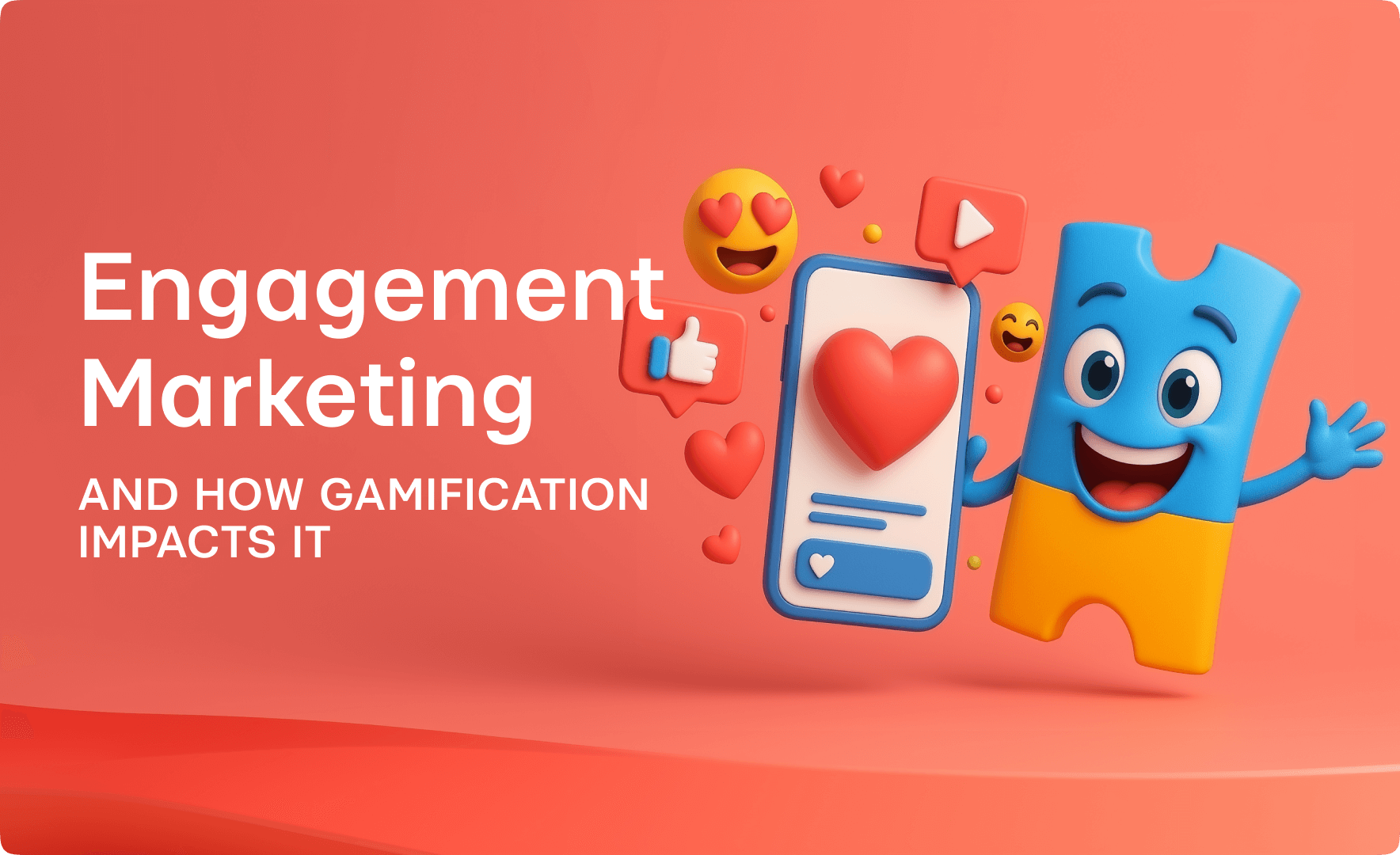
Today, attention is no longer the main goal.
Interaction is.
This is the core of engagement marketing: shifting from one-way communications to meaningful exchanges that invite customers to act, respond, and return. With the implementation of game-like mechanics (points, challenges, and rewards) into a digital engagement plan, you transform routine interactions into compelling experiences. In fact, studies show that gamified campaigns can increase customer engagement by up to 48%!
This proves that play is not only fun but also a serious marketing engagement strategy.
That boost is, of course, improving metrics. But it also drives loyalty, retention, and advocacy. All the key outcomes of effective customer engagement campaigns.
Winday has made it all practical. With no-code access to Instant Games and Marketing Tournaments, businesses can apply gamification to their engagement in digital marketing strategies. Without technical hurdles or extra budget burdens. The outcome is not only engaging marketing but campaigns designed to sustain attention and build long-term value.
In this article, we’ll explore:
- What is an engagement marketing definition
- Real-world strategies to implement engagement based on game mechanics
- How gamification impacts engagement metrics
- How Winday enables interactive marketing campaigns without needing to add coding
- Step-by-step explanation on how to integrate gamification via Winday
What Is Engagement Marketing?
Engagement marketing is a strategy that uses a variety of elements to make interactions with customers active. Customers are encouraged to participate and engage with brands. The main ways to implement that can be classic social media activities we all know very well – giving feedback or sharing. However, the better way to do it might be through interactive tools or gamified activities.
What is engagement marketing compared to traditional marketing?
Traditional marketing often relies on reach and volume. For example, we all know well about these ads designed to be seen as many times as possible. Engagement marketing, by contrast, values depth over breadth.
The key question behind engagement marketing is: How meaningfully did the customer interact with us? Rather than simply: Did they see our ad?
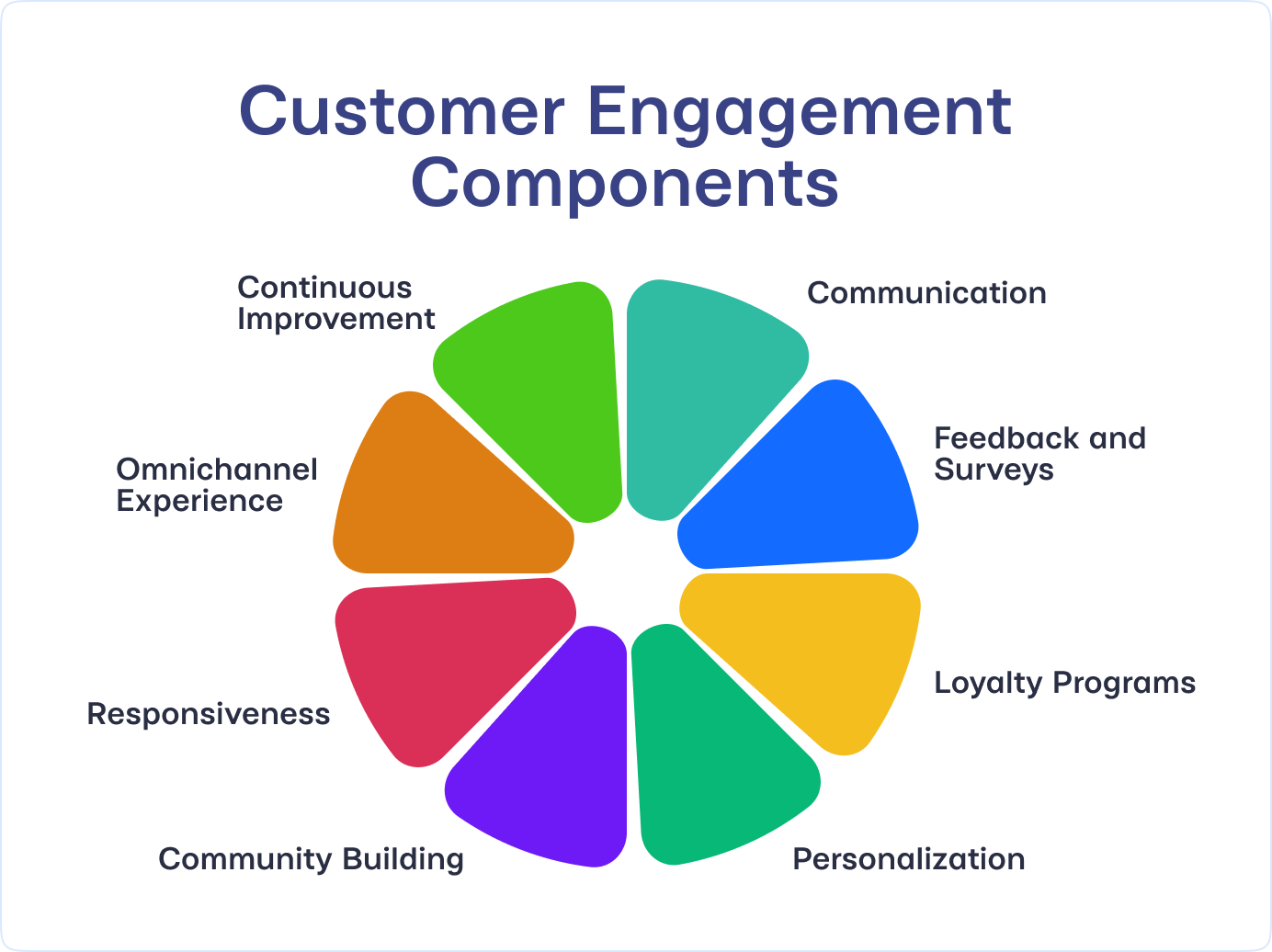
The image illustrates the concept of engagement marketing as a customer-centric approach.
Key Components of Engagement Marketing
Personalization: Engagement in marketing starts with relevance. Today, most users expect their preferences to be met. How, exactly? Through personalized offers, tailored messages, or custom product recommendations. Thus, you will see higher interaction rates.
Multi-channel touchpoints: Modern customer engagement campaigns work across platforms: social media, apps, email, and even in-store experiences. That’s why it is important to connect these touchpoints; brands have to create an engaging digital marketing flow where customers can interact wherever they are.
Interactive experiences: Today, people have more expectations toward interactive content. Customers want engaging games, polls, quizzes and interactive ads. All the forms of engagement advertising that invite action, and not only passive viewing.
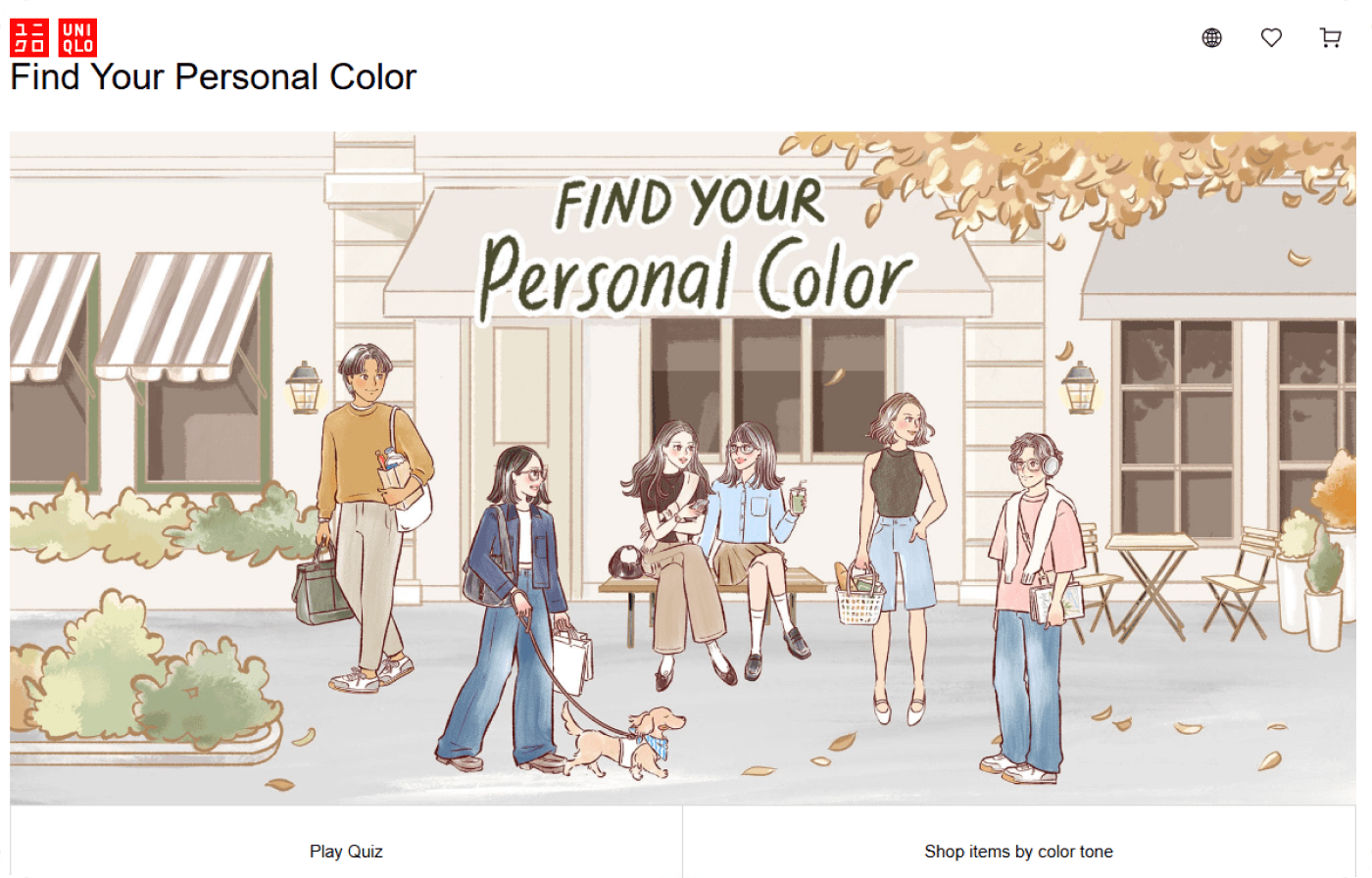
On select regional sites, Uniqlo offers an interactive quiz that helps you discover your personal color palette (e.g., Spring, Summer, Autumn, or Winter). You get style-matched clothing suggestions based on your results.
Why is Engagement Marketing Essential in 2025?
These days, consumers are faced with more content than ever before. In fact, we’re spending more and more time interacting with different online formats. On average, the screen time is 7 hours and 4 minutes.
A marketing engagement strategy relies almost completely on interaction and not on exposure, like it’s traditionally done. Keeping attention is important, but there’s more to it; engagement builds relationships.
The rise of gamification works really well with this shift. If you simply add more interesting, playful elements with rewards to a digital engagement plan, you will meet this pressing need for interaction.
Benefits of Engagement Marketing for Business?
An effective customer engagement in marketing creates advantages that are not limited to other clicks. Its value is seen in long-term business performance:
Deeper customer loyalty and stronger relationships. Just like in everyday situations (and if you think about it, buying products is one of these situations), when people are engaged, feel seen and valued, they feel good in relationships. Similarly, the likelihood of customers staying with a brand over competitors is higher.
Higher retention and repeat purchases. To put it simply, interaction leads to habit formation. Customers who engage regularly are far more likely to return and buy again.
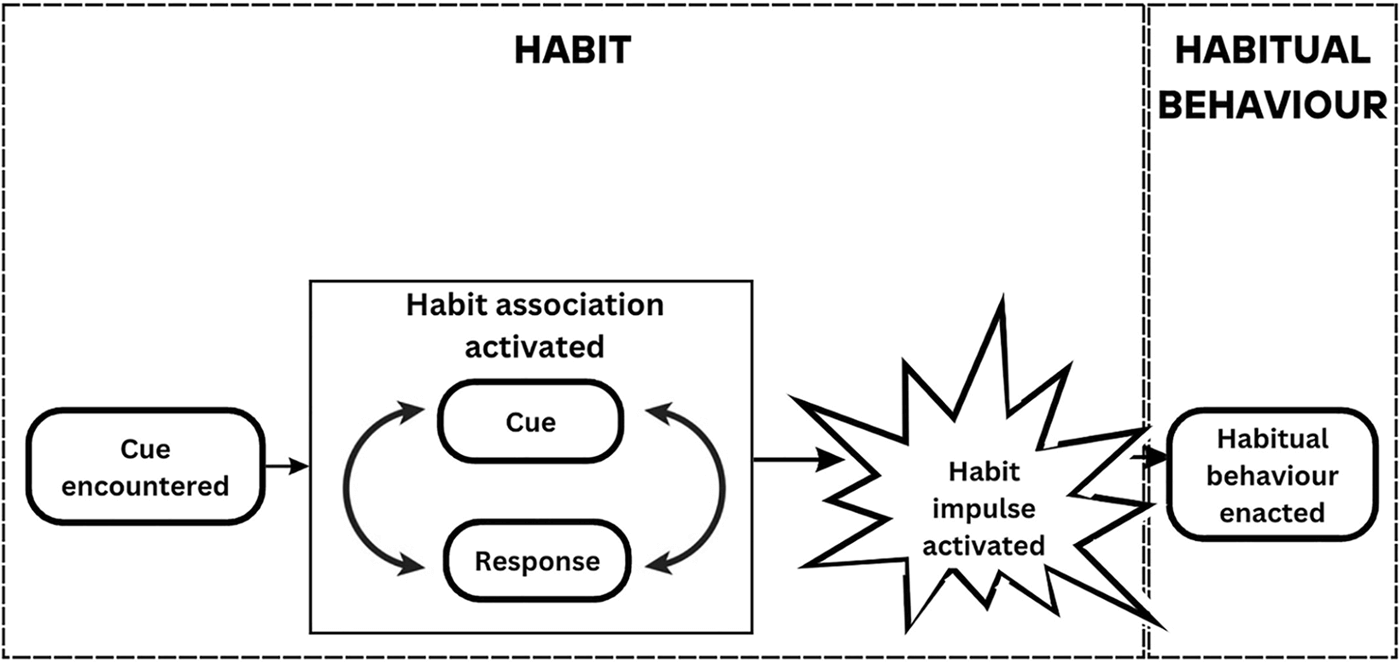
This image illustrates the process of habit formation and habitual behavior.
Emotional connections and advocacy. People tend to treat brands like actual people. Of course, we don’t do that consciously, but brand communication, how they respond to important social issues are of huge value for customers. And naturally, if brands add engagement in digital marketing, it will build emotional ties. When customers feel connected, they often advocate for the brand; they share experiences with peers and strengthen word-of-mouth growth.
Better campaign performance. Compared to passive campaigns, engaging marketing have higher click-through rate, improved conversion rate, and stronger ROI. That’s understandable – people are invited to participate, they feel emotional or at least interested. People are more likely to act when they are involved, not just watching.
💡 Did You Know?
Customers who are highly engaged deliver around 23% greater value in terms of spending, profitability, revenue, and long-term relationship growth compared to the average customer. This is clear evidence that engagement marketing drives business performance.
Effective Engagement Marketing Strategies
If you still rely on traditional advertising, don’t expect guaranteed results. The reason for that is, essentially, very simple. Customers are not looking for typical messages they’ve seen a million times. They want meaningful brand communication that offers them to be a part of something fascinating.
A strong marketing engagement strategy includes interactive campaigns, and it simply does not exist without personalization. Plus, if you add well-timed communication, you will see that customers are not only more active but also emotionally invested.
At this point, gamification can enhance existing approaches. Using Winday, businesses can stop making ordinary interactions and create rewarding experiences. For instance, you can start by making campaigns part of daily habits and not typical one-time impressions. Below is a practical example of how this works in action.
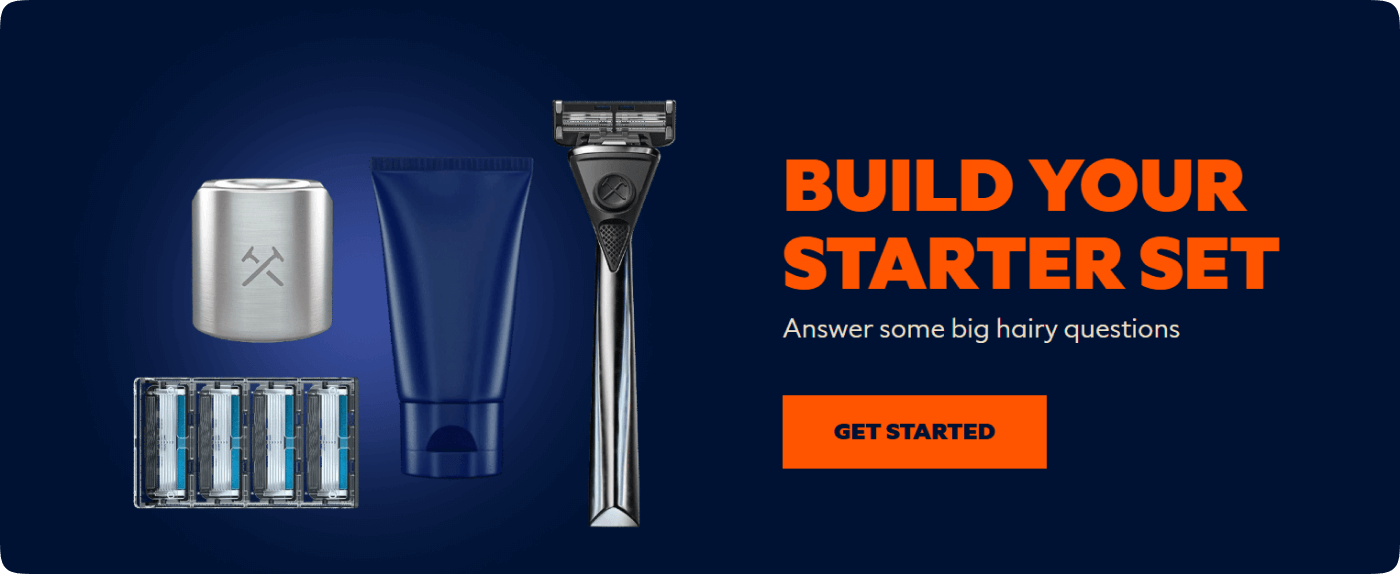
Dollar Shave Club uses gamification through quizzes to help people discover the product that suits them best.
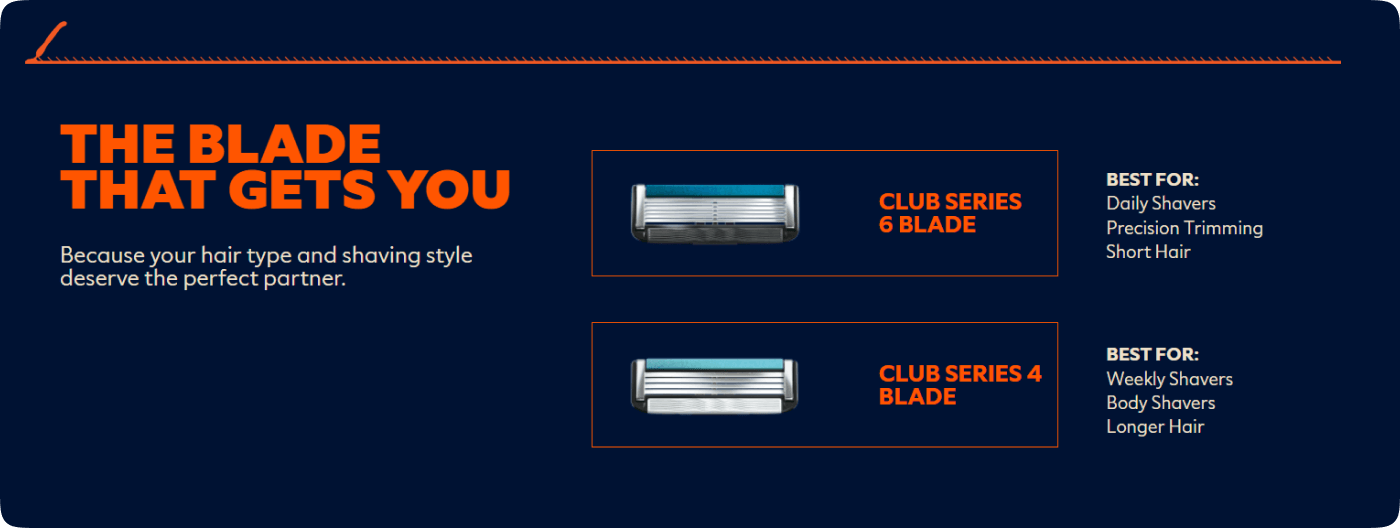
Warm Welcome Messaging
There is nothing more important than first impressions in engagement digital marketing activities. The way a brand greets new users sets the tone for the entire customer relationship and affects, in many ways, how they may proceed.
Any early interactions help establish trust and impact long-term loyalty. But if you make them powerful and inviting enough, the effect can be literally amazing.
An effective onboarding flow most usually includes:
- Personalized greetings that address the customer by name.
- Welcome emails that tell what the customer can expect from the brand.
- Push notifications with tips, offers, or relevant content.
It is highly important to design these things thoughtfully. Later, they contribute very well to higher retention rates.
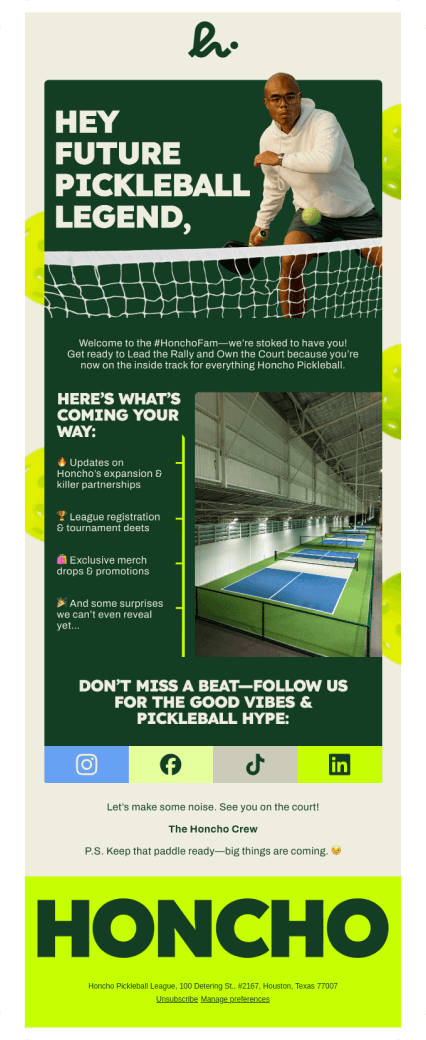
A welcome email design for Honcho Pickleball League.
📘 Pro Tip:
If you are designing a customer engagement campaign, make sure you don’t add 1000 mechanics at once. In 99% of cases, a simple interaction works better than a complicated journey.
Example in practice:
Let’s say you have an e-commerce store. You could launch a welcome Instant Game powered by Winday for first-time visitors. What’s next?
- Greet new visitors with a pop-up that teases an exclusive discount or promo code, along with a link to play a fun game to win it.
- Or give shoppers the chance to play and instantly win a discount on their order at checkout step.
- After purchase, follow up with an email featuring a link to the game, where they can score a promo code for their next order.
This is an interactive experience already, which might affect the initial excitement, and, moreover, increase the likelihood of another visit. So, it is not a standard welcome that you can see on every single site out there, but a truly engaging marketing moment.
Personalized Content and Offers
One of the strongest drivers of customer engagement in marketing is relevance. That’s understandable, right?
Everybody feels like responding when the content they receive feels personalized to them. On the contrary, if you keep broadcasting generic offers to everyone, then… Well, it’s hard to expect much engagement. Personalization plays a critical role in any marketing engagement strategy.
However, adding a customer’s name to an email may have been personalization in the past. But today it is just a very normal thing. Real personalization includes tailored product suggestions based on past purchases, genuinely interesting website content. Maybe targeted offers that reflect a customer’s interests. If you do that correctly, personalization makes communication feel natural. And when it’s a conversation rather than a generic announcement, people will enjoy and invest more in that.
Exclusivity builds on this foundation. When customers are given access to something “just for them”, it creates a sense of value and urgency. In engagement advertising, VIP programs, birthday discounts, or early-access campaigns are good ways to make people recognize. Plus, it is a fair reward for their loyalty. This approach uses two powerful motivators: FOMO and the satisfaction of being part of an insider group.
For instance, a brand can add a VIP tier available to loyal customers. You can also add a touch of personalization by sending gifts in a birthday email. These experiences are small on the surface, right? But they add up to a significant boost in loyalty and retention over time.
Example in practice:
Gamification can make this approach even more compelling. Using Winday Instant Games, businesses can distribute exclusive promo codes to specific customer segments. Imagine a scenario where first-time buyers receive access to a quick game that gives a one-time discount, while returning customers play for loyalty points or early-access passes. Does it deliver value? Yes. However, there is more: an interactive step that makes the reward more memorable.
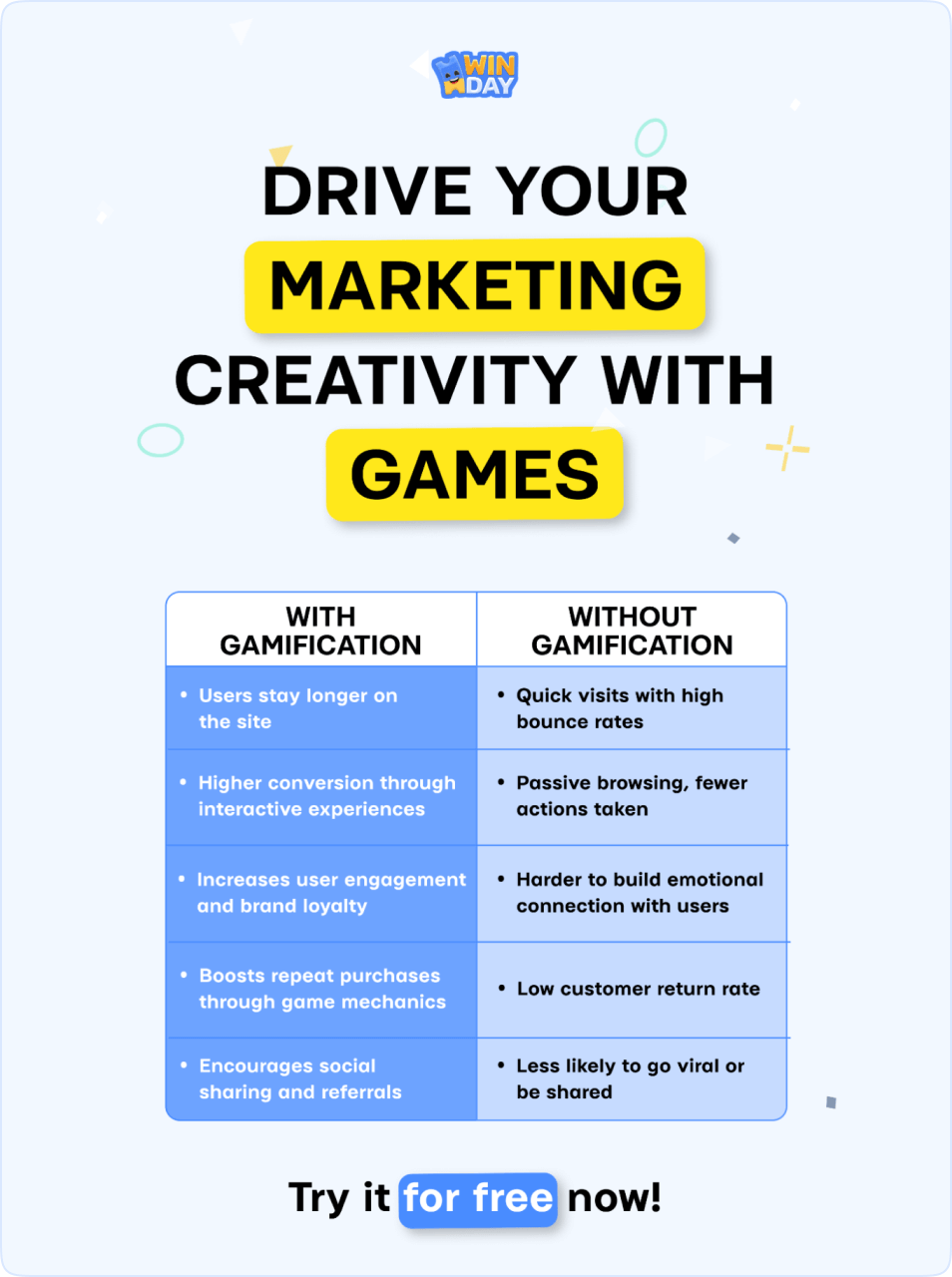
A comparison table on how gamification affects marketing.
The psychological effect is twofold:
- Personalization makes the offer relevant.
- Exclusivity creates anticipation and urgency.
Together, they form a cornerstone of engagement in marketing, which is moving the interaction from passive consumption toward active participation.
Omnichannel Engagement Integration
Modern customers don’t interact with brands in just one place. After all, it is simply not possible! They may discover a product on social media, browse it later on the website, and eventually make a purchase through an app. This is why omnichannel engagement has become an essential part of any customer engagement marketing strategy.
Omnichannel engagement is the practice of creating an easy customer experience across multiple platforms. It may include, but not be limited to, email, social media, in-app notifications, and websites.
The main thing is to provide consistency. Customers expect the same tone of voice, visual identity, and promotional offers no matter where they interact with the brand. Even when we are talking about engagement digital marketing, these details matter. When these touchpoints feel connected and not fragmented, it builds trust and strengthens overall customer engagement in marketing.
For example, you can launch a campaign that starts on Instagram with a teaser post. Then, move to an app with a Branded Instant Game, where users can play to win rewards. On the last step, the customer completes the journey on the brand’s website to get a prize.
And no, you don’t need to plan and construct three separate interactions. The customer experiences here are a part of engagement in digital marketing that feels intentional. Besides, what’s maybe even more important, it is smooth.
This integration works well for the reach. If you connect campaigns across channels, your business can appear to the customers where they are most likely to be. How does it work? If a shopper ignores an email, that’s okay, because he might respond to an Instagram story. If someone skips a social media ad, they could still engage through a QR code in a physical store.
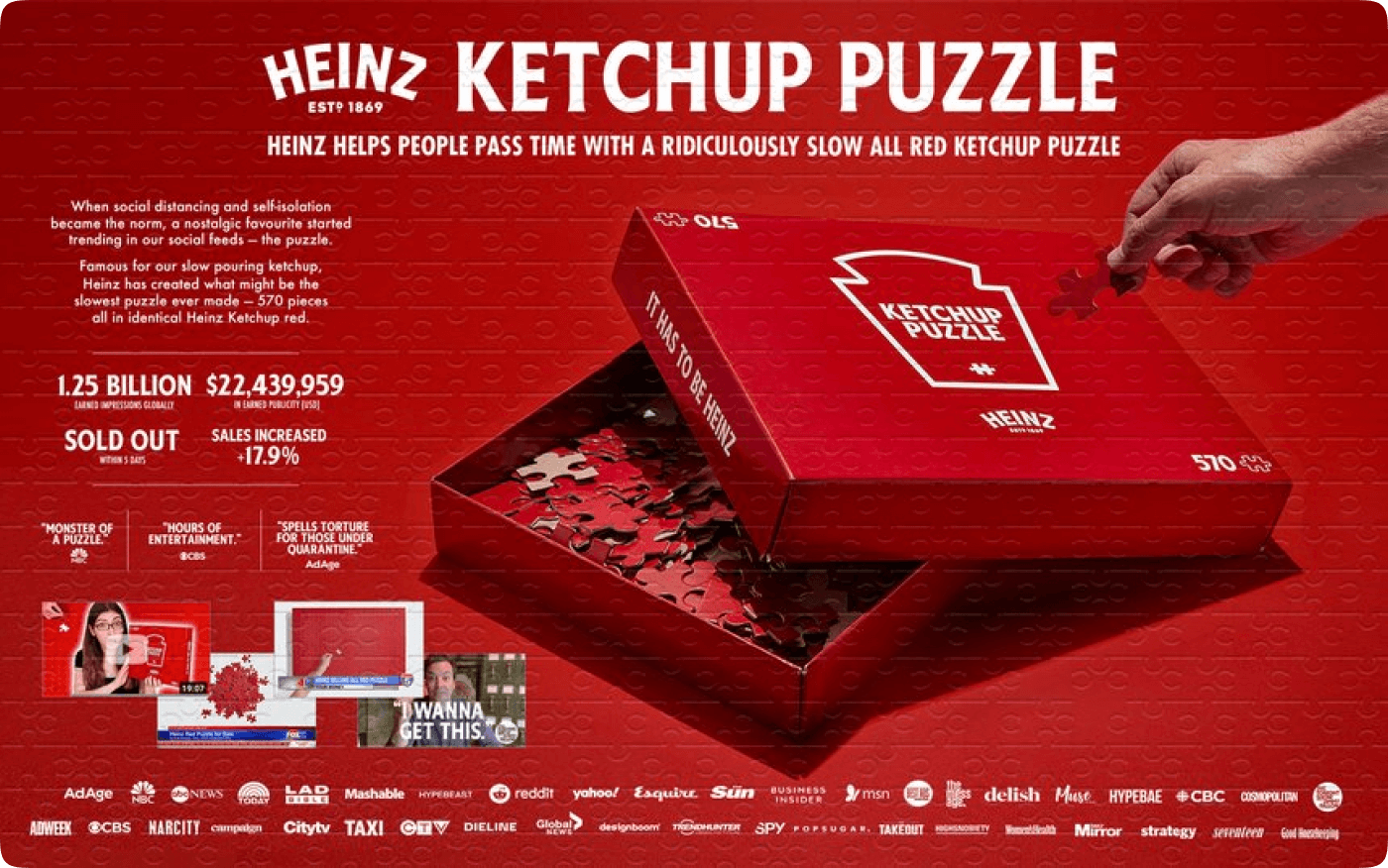
Heinz created a real, physical product (a 570-piece all-red puzzle) that connects directly to its brand story: Heinz ketchup is famously “slow,” and the puzzle is equally slow and frustrating to complete. They launched and amplified it across social media, including Instagram, Twitter, Facebook, and TikTok, where people were sharing their quarantine hobbies.
Winday makes this approach very practical. There is no-code setup, so you don’t have to create elaborate schemes on how to launch a successful campaign. Brands can launch customer engagement campaigns that stretch across multiple entry points:
- Winday Club audiences already know about Instant Games.
- Social media promotions in your accounts drive users to interactive tournaments.
- Branded emails linking to personalized offers or rewards.
- Offline visitors can scan a QR code to join the same game or campaign instantly.
This integration makes every channel complement the others. There is no need to compete for attention.
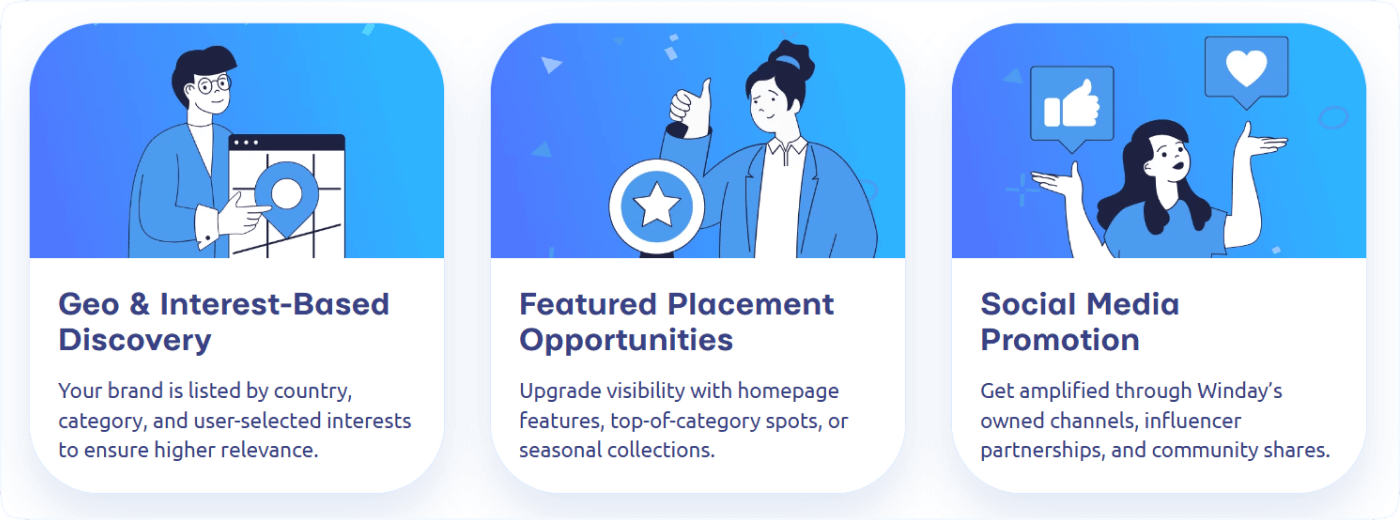
The advantages brands get from being a part of Winday Club.
Ultimately, omnichannel integration strengthens engagement advertising. Why? Because it delivers one message through multiple pathways that are connected and lead from one to another. It enhances reach and retention, which helps brands to build deeper loyalty. Meanwhile, all the campaigns are measurable and scalable. For businesses in 2025, it is no longer optional. It’s the standard that customers expect.
Customer Loyalty Program
Keeping customers engaged beyond a single purchase is one of the biggest challenges when it comes to modern engagement in marketing. Loyalty programs offer a proven solution: they reward repeat interactions and create incentives for customers to stay connected.
Point-based systems are the most common and probably the best choice here. Customers earn points for every purchase, review, or referral. All of that can be later redeemed for discounts or products.
Tiered memberships offering status levels that open up increasing benefits. The structure uses a sense of achievement, making people more motivated to keep engaging to “level up”.
Surprise rewards are another powerful thing. It is all very familiar to us: unexpected coupons, free shipping on a special day, or bonus points for returning after a break. Probably, everyone encountered these rewards and maybe used them. These moments are exciting, and even if customers know it’s part of a marketing strategy, they still feel valued. They are not generic transactional benefits. These rewards build emotional connections, which are critical for long-term loyalty.
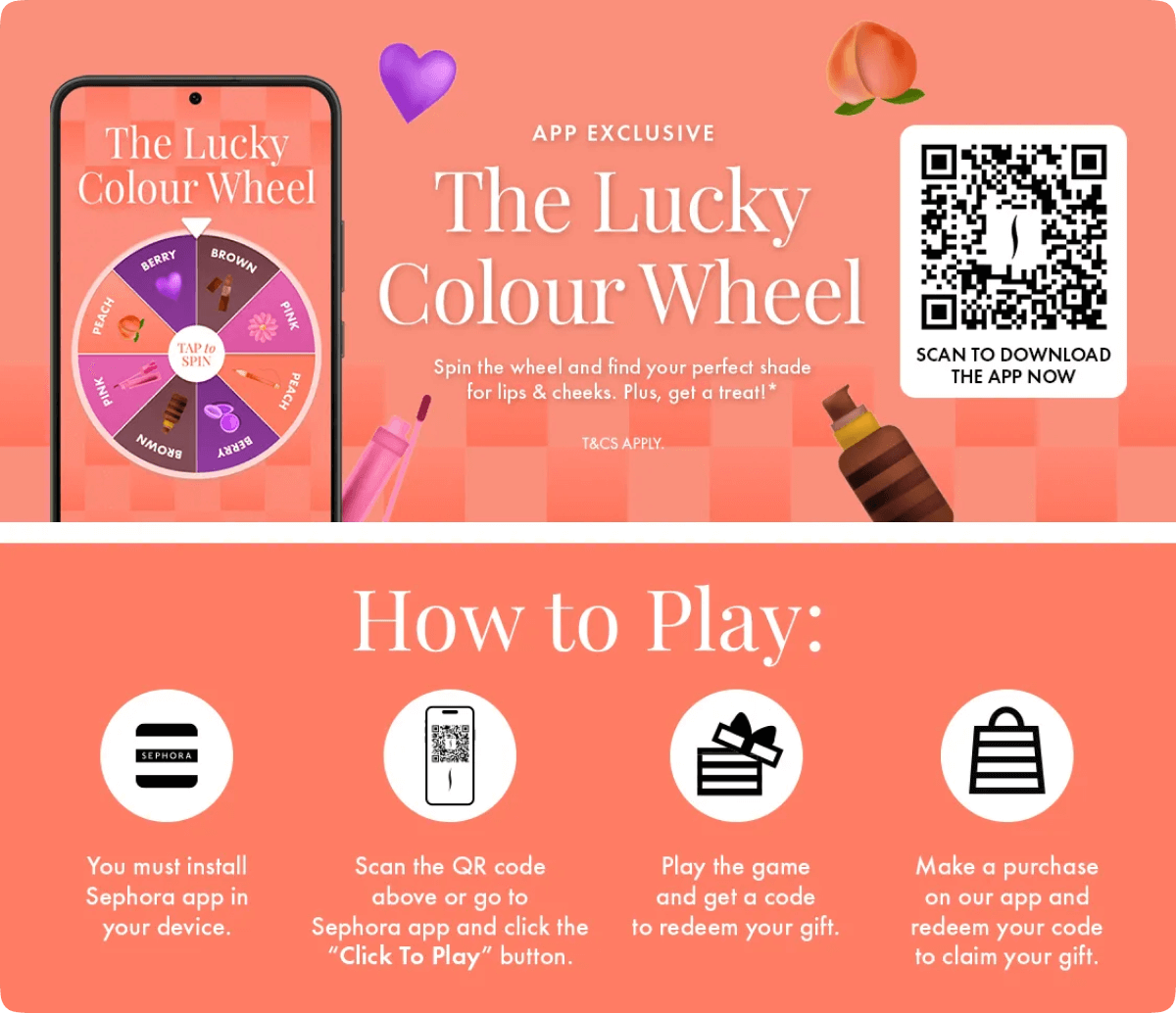
An example of Sephora gamification.
If you add Winday’s offer, you can only make these programs better and stronger. In Instant Game, players might earn loyalty points. If you combine recognition and play, it will affect the feeling of participation. It will be fresh and genuinely enjoyable, and isn’t what people are looking for these days?
If you think that loyalty programs are only about discounts, you are definitely wrong. They are about customer engagement campaigns that recognize, reward, and retain customers. Now, if you tie them to a broader digital engagement plan, they create lasting emotional bonds. Plus, that will affect repeat business.
📘 Pro Tip:
Don’t reward only purchases. Reward engagement as well. Points for reviews, social shares, or participation in gamified Instant Games encourage customers to stay active beyond checkout.
Engaging Social Media Campaign
Social media has long outgrown its role as just a broadcasting tool for brand updates. Today, it’s one of the most powerful platforms for two-way conversations with customers. People expect brands not just to “talk at” them, but to engage, respond, and interact truly engagingly.
The best engagement marketing strategies on social platforms lean into this dynamic. Forget about pushing static ads! Brands have to build interactive moments.
Contests, challenges, and polls are especially effective strategies. Live Q&As and user-generated content campaigns, on the other hand, help foster transparency and give customers a voice, creating a stronger sense of belonging.
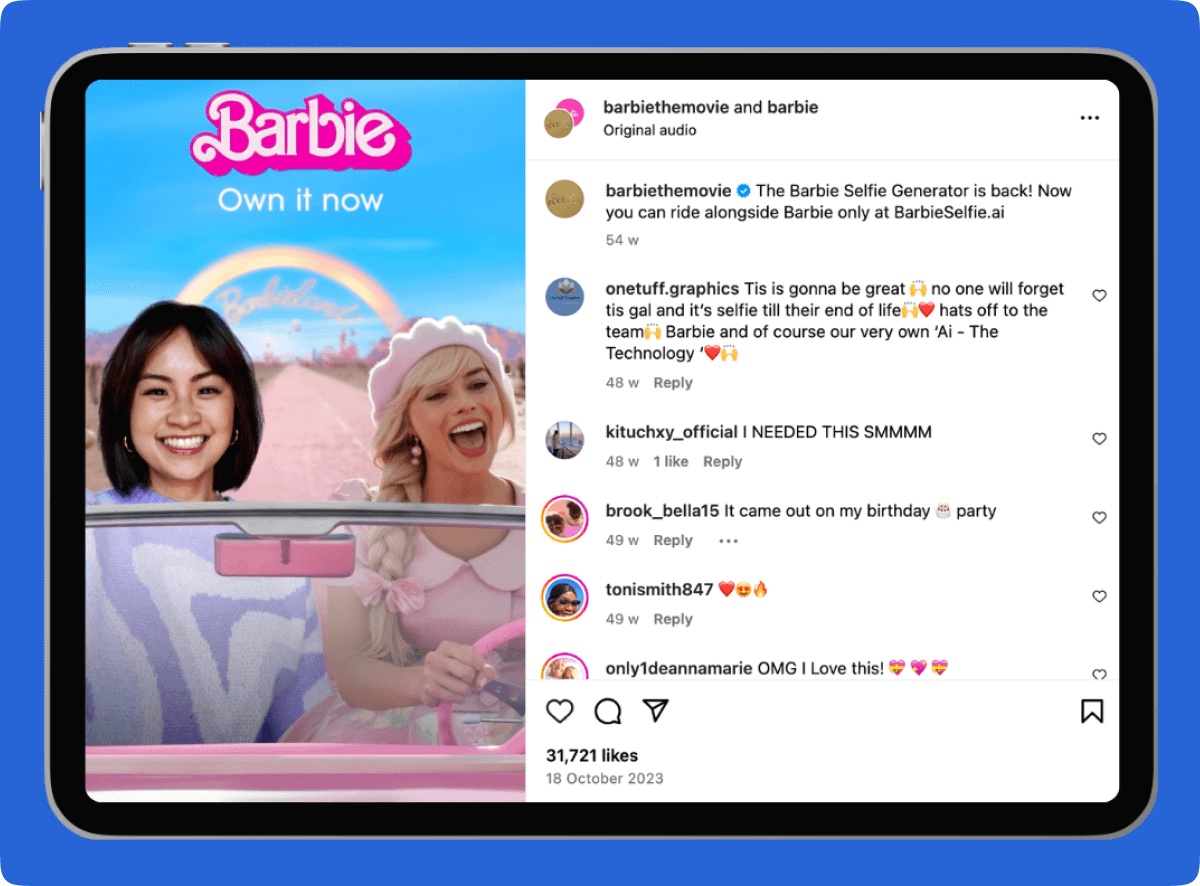
A campaign that engaged the audience with Barbie’s AI selfie generator.
Winday Marketing Tournaments are a creative way brands can promote fun competitions on their social channels. For example, you can announce the tournament through Stories or posts in your social media channels. In that case, users can click through to play and compare with others, and additionally they can easily share info about tournaments with friends.
Does this drive participation? Yes.
But it also changes the nature of brand engagement. It makes it a shareable experience.
The main appeal of gamified campaigns is in their virality potential. If you think about it, social media is built on content that people share a lot and quickly. When a customer enjoys a game, wins a challenge, or earns a reward, they’re most likely to post about it. This creates organic buzz. Moreover, it amplifies reach and gives your campaign an exponential lift without additional ad spend.
💡 Did You Know?
The term customer engagement got its first formal definition in March 2006, when the Advertising Research Foundation (ARF) described it as “turning on a prospect to a brand idea enhanced by the surrounding context”. Just a year later, in 2007, Forrester Research elevated engagement to marketing’s new key metric, defining it as “the level of involvement, interaction, intimacy, and influence an individual has with a brand over time”.
How Gamification Impacts Engagement Marketing
Gamification takes the mechanics we usually associate with games – points, challenges, rewards, and levels. And… it simply plugs them into marketing. What is the goal of such an approach?
First of all, to invite people to participate. Humans are hardwired to respond to progress, competition, and rewards. It might be something simple – unlocking a badge, hitting a streak, or winning a prize. In any case, these small wins add up to big boosts in engagement.
Psychologically, gamification uses powerful triggers: the thrill of unpredictability, the urgency of FOMO, and the little dopamine hit that we all love and seek. They come with completing tasks or earning rewards. Gamification changes interactions with brands. They become not only more memorable but also more motivational.
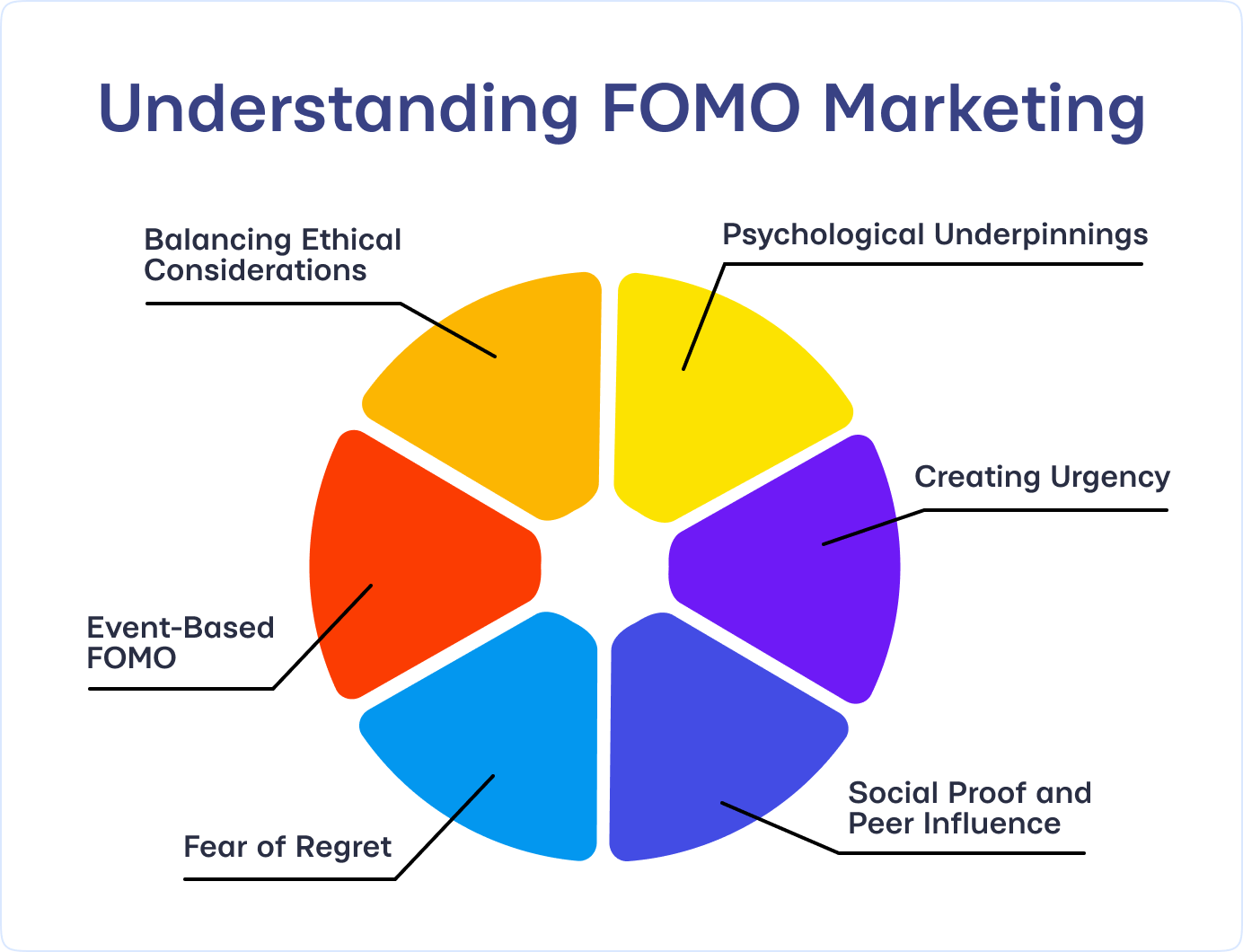
FOMO is a powerful marketing tactic that relies on a variety of triggers.
For businesses, this impact is measurable. Gamification enhances one of the most important marketing variables: personalization.
However, it also helps to segment target audiences based on behavior. With all the data collected from gamified interactions, your brand can work on better campaigns and introduce even better engagement.
For example, a single campaign can reach customers across Instagram, email, or even offline through QR codes.
Benefits of Gamification in Engagement Marketing
Gamification isn’t about sprinkling in a little “fun”. While it does make campaigns enjoyable, its true purpose is strategic: to build engagement, loyalty, and long-term brand growth. Gamification is a strategic framework that strengthens customer engagement, builds loyalty, and drives long-term brand growth. Brands introduce competition, recognition, and tangible rewards, which give customers reasons to keep coming back.
Enhances User Motivation and Fun
When customers can earn points or receive instant rewards, they build habits. This is where psychology does the work. Every spin of a wheel, completion of a challenge, or surprise bonus triggers dopamine release, offering instant gratification. Add FOMO into the mix (the examples can be endless – limited-time challenges or exclusive leaderboard spots), and customers become even more motivated to participate.
For example, a retail brand could run a Winday mini-tournament campaign where users earn points every time they play, with bonus rewards for winners. Casual shopping, in this way, can turn into a streak that customers want to maintain. What does your brand get then? Exactly, engagement and sales.
Drives Higher Interaction Rates
Gamified campaigns are proven engagement boosters. Here’s the thing: passive ads hope for a scroll-stopping moment. What about interactive campaigns then? They invite participation.
The numbers speak for themselves: brands using gamification often see 30–60% higher engagement. It includes many things, from likes and shares to longer dwell times. Simply put, when audiences play, they stay.
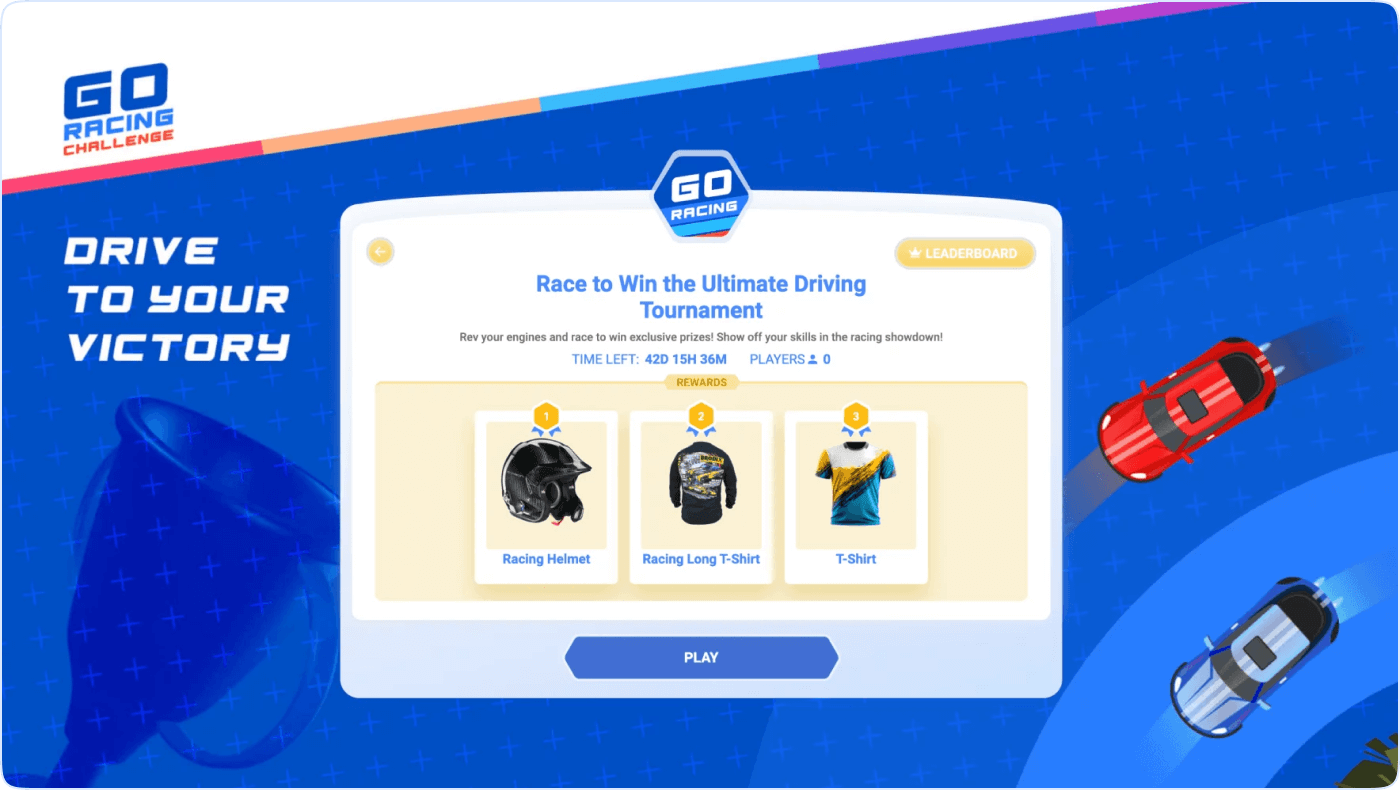
Here’s how a racing gear brand can launch its own racing-style game on Winday’s gamification platform.
Collects Valuable Data Through Gameplay
Every tap, swipe, and replay tells a story. Gamified experiences, of course, entertain, but this is only on the surface. Deeper, they generate zero-party data, including directly shared preferences, behaviors, and demographics. If you compare it to third-party cookies, this data is willingly given. So, you have another big advantage: the data you receive from customers is more accurate and actionable. As a result, you have sharper segmentation and hyper-personalized campaigns that keep hitting the mark.
Builds Community and Loyalty
Remember how games affect kids? Right, they naturally spark a connection. All the elements work well and for adults – leaderboards, team play, or shared challenges make customers not just buy things, but participate. Plus, it creates a brand-driven community. It builds emotional bonds. A consumer might forget a banner ad, but they won’t forget the time they beat their friends in a branded tournament.
Differentiates Brands in Crowded Markets
We are all constantly flooded with lookalike ads. Thus, gamification is a true category breaker. By blending play with marketing, brands can create memorable experiences that stand out in crowded markets. Instead of being “just another campaign,” they become the story customers talk about, share, and return to. If you think about it, it is more than a simple engagement, but a proper brand differentiation.
Comparison Table: Traditional vs. Gamified Marketing Campaigns
| Metric | Non-Gamified Campaign | Gamified Campaign | % Change | Notes |
| Engagement Rate | 46% | 68% | +48% | Represents average customer interaction (e.g., likes, comments, time spent) |
| Average Session Duration | 2,1 min | 3,6 min | +72% | Time users spend interacting with campaign content. |
| Click-Through Rate (CTR) | 1,6% | 2,5% | +38% | Rate at which users click on calls-to-action or links. |
| Bounce Rate | 42% | 27% | -40% | Percentage of users who leave without interacting further; lower is better for retention. |
| Conversion Rate | 2,5% | 6,2% | +148% | Rate of users completing desired actions (e.g., purchases); can reach 7X higher in some gamified scenarios. |
| Social Shares (per 1,000 Users) | 84 | 246 | +193% | Number of shares or viral actions; gamified content is shared up to 12X more. |
Launching Gamified Engagement Campaigns
If gamification sounds complex, Winday makes it easy, plug-and-play. With flexible tools, no-code integration, and fast setup, brands can launch campaigns in minutes and not dedicate months, as well as giant budgets to run engaging campaigns:
1. Define Your Goals.
It is important to understand what success is for your brand in this particular context. Do you want more website visits, or maybe stronger product promotion? Are you looking for customer feedback? Your goals will dictate to you which game mechanics to choose, as simple as that.
2. Choose the Right Game Type and Mechanics
Winday gives you two main gamified formats:
Instant Games: Quick, interactive experiences that reward players instantly. These games show higher retention, as such offers motivate users to interact much better (online or in-store). They have also been shown to achieve a +49% engagement rate and 10x longer interaction time.
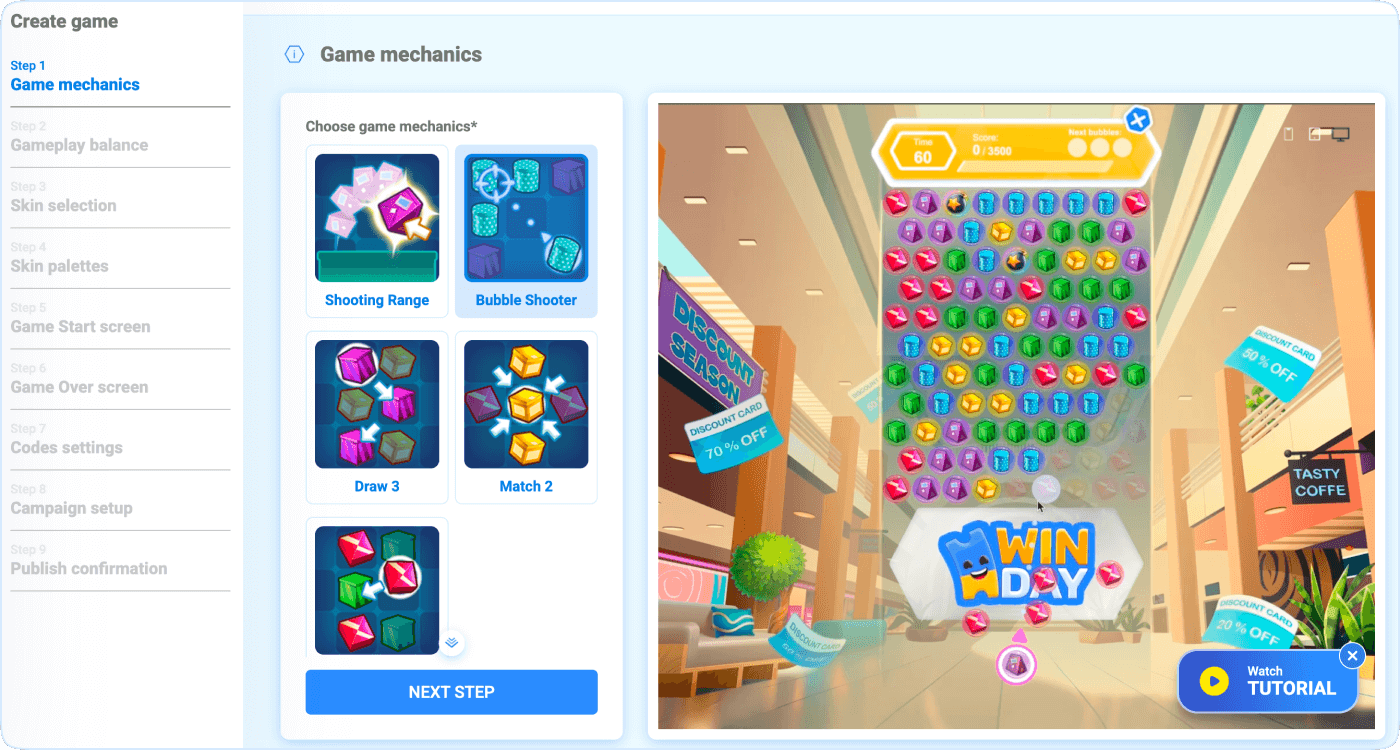
Game mechanics options on Winday’s dashboard.
Tournaments: Longer competitions where users play repeatedly, climb leaderboards, and chase prizes. You can apply them if your goal – or one of the goals – is community-building.
Game types you can plug in: Match 3, Match 2, Bubble Shooter, 2D Shooter, Draw a Line. These are classic formats audiences already love and are already familiar with, so there is no learning curve needed.
3. Customize Your Campaign (No Developers Needed)
Since Winday provides a no-code editor, campaign setup is extremely easy. You can start by adding visuals and brand elements, or you can just choose from the skin selection that the platform offers. Alternatively, you can just contact us and have a specially customized choice.
On the next step, you need to define rewards. There are many options; just choose what works best for your brand. You can also add newsletter sign-ups, product shares, or referrals.
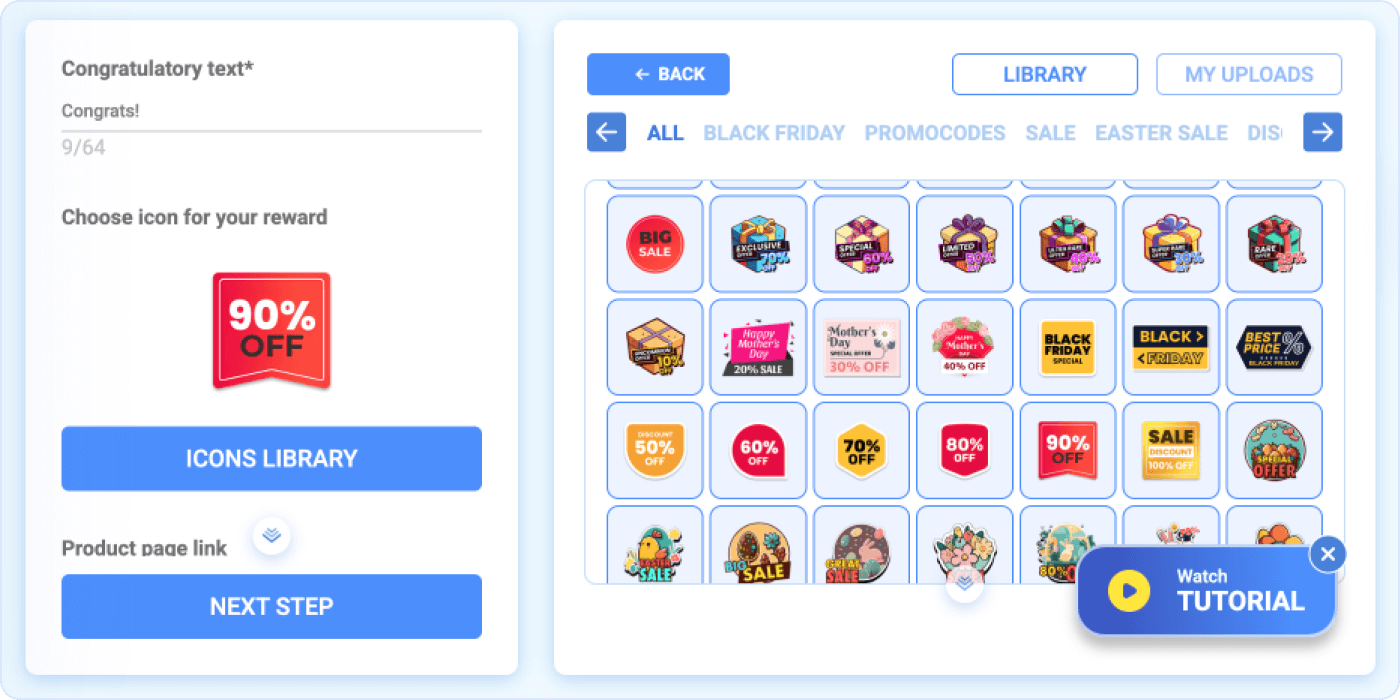
Finally, embed across platforms: website, mobile, or social channels.
4. Measure KPIs
A marketing campaign can only succeed if you use analytics. It’s important to keep an eye on all the traditional metrics: engagement rate, repeat sessions, and conversions. However, if you have more to track, even if it’s a lot, keep doing it.
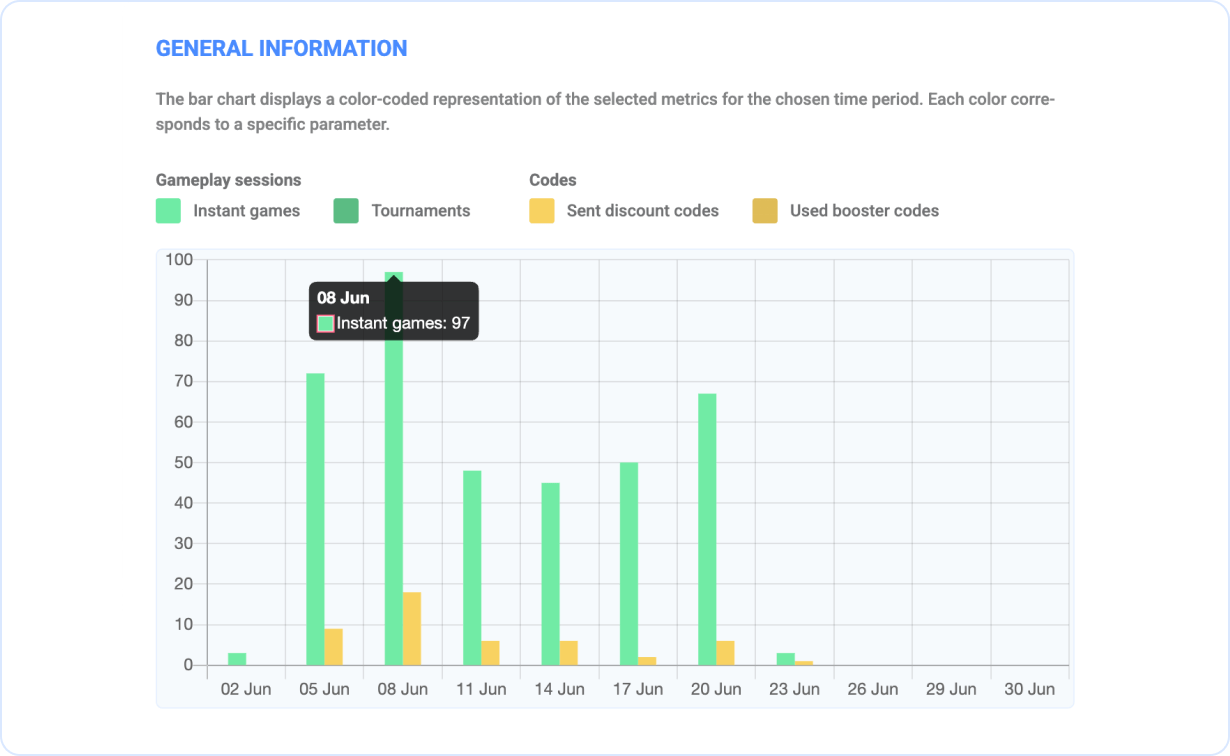
General analytics dashboard on Winday.
5. Make Changes when Needed and Personalize
Any customer engagement marketing strategy needs updates. For holidays, seasons, or user segments. Personal touches can work wonders, so if you add offers based on gameplay data, you’ll see a lot of positive changes.
Final Takeaways
Engagement marketing is all about one thing: sparking a two-way conversation. The most effective campaigns provide interactivity, emotional connection, and repeat participation. You don’t have to guess a lot: this is exactly where gamification shines. It changes ordinary marketing that is boring and makes it more playful, rewarding, and memorable.
When using Winday, there is no need to be a developer or game designer. Marketers can launch gamified campaigns in minutes, plug them into websites, social media, or mobile apps, and watch engagement rates rise. You can use Instant Games to establish quick interactions, or Tournaments if you need long-term engagement. As a result, gamification affects loyalty, data collection, and brand visibility.
👉 Ready to drive engagement with Winday’s gamified campaigns?
Rate this article
FAQ
Keep Learning
What is Brand Engagement and how to increase it with Gamification
What is brand engagement, and what is the role of gamification in it? In a this article, we explore brand engagement and how gamified elements can improve it in your business.
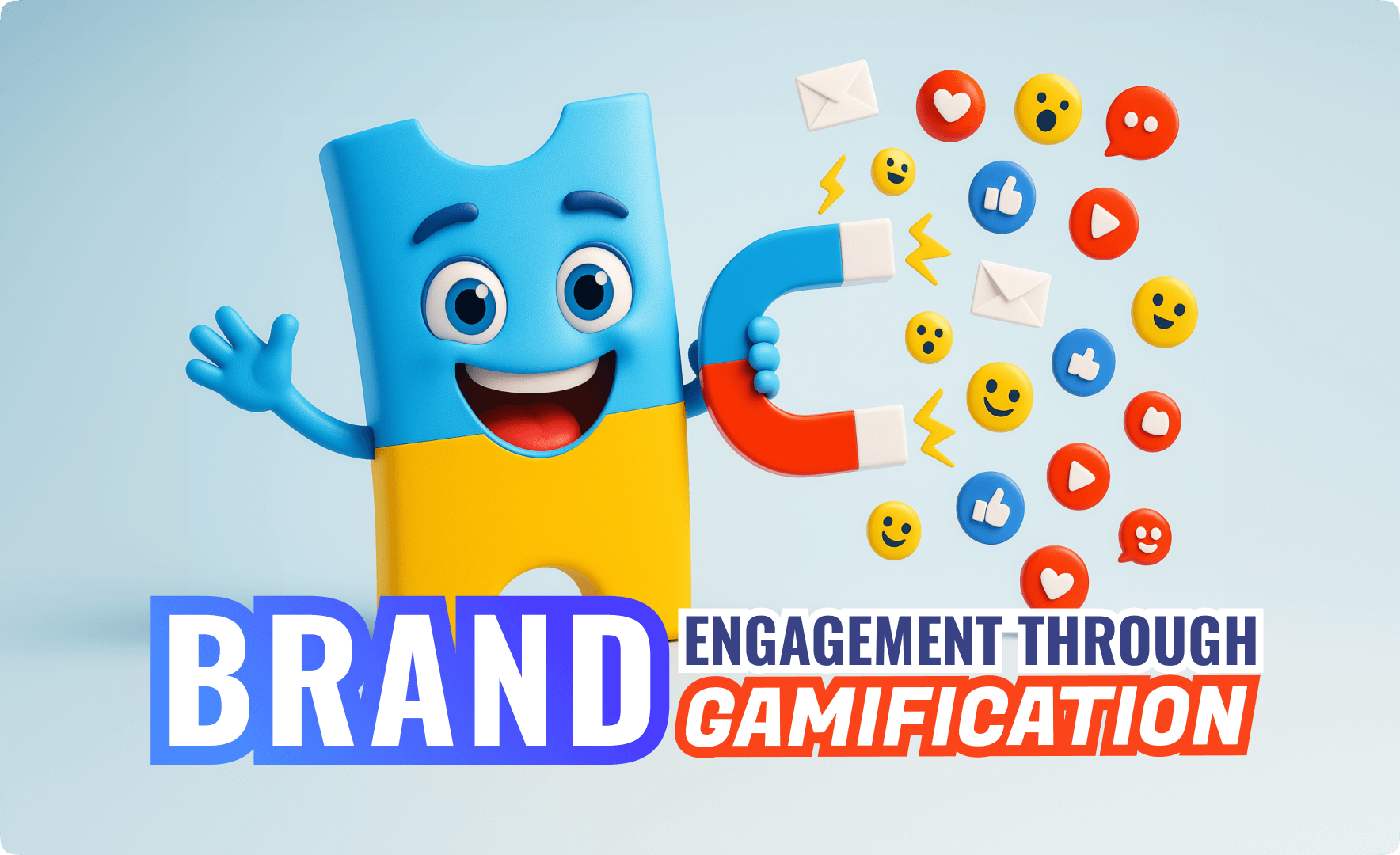
Customer Engagement in Coupon Marketing
Learn what coupon marketing is, what types of coupons fit best for your campaign, and how to boost your coupon campaign with gamification.
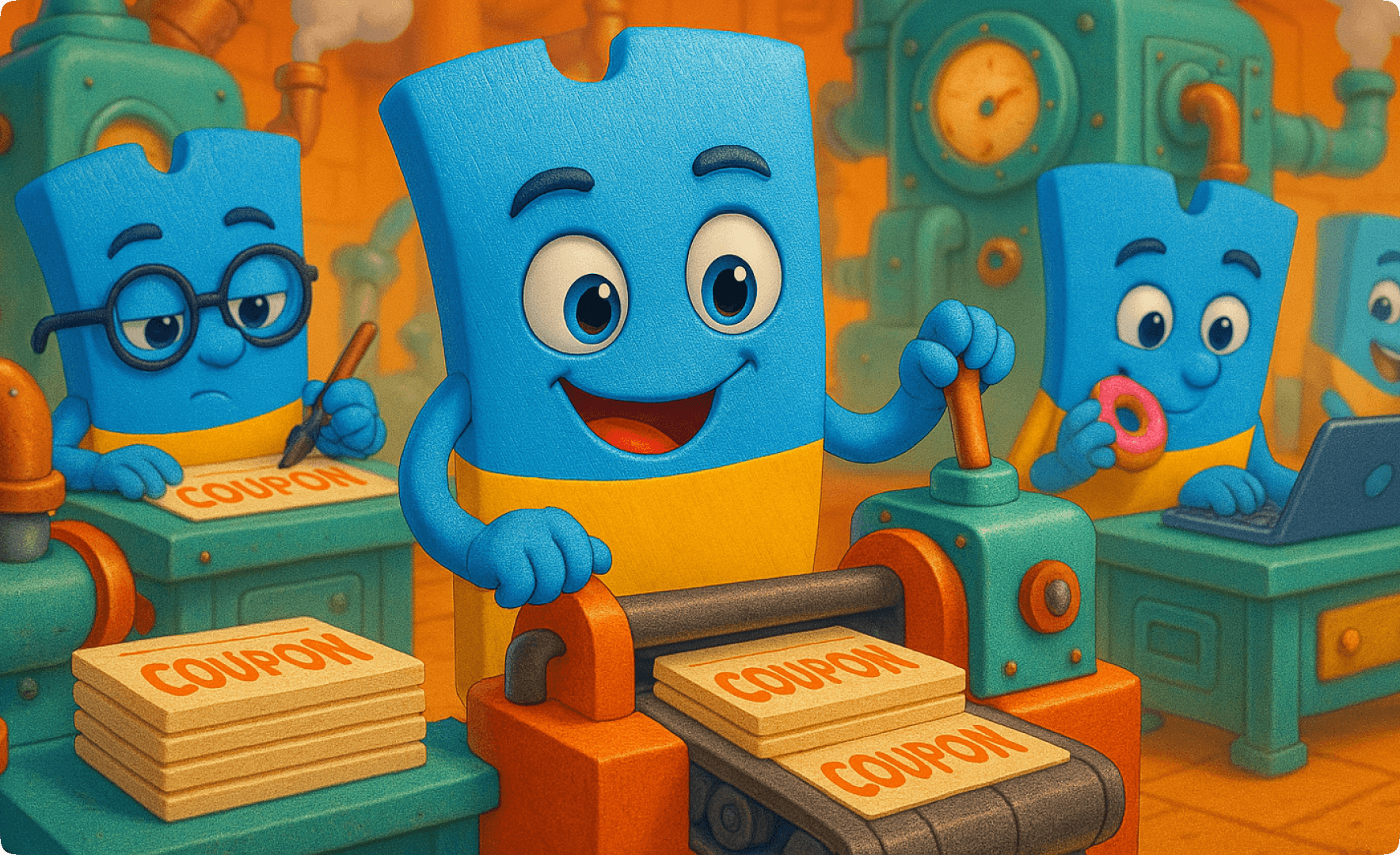
Sales Promotion Ideas and How to Enhance Them with Gamification
Selling today is part art, part smart tactics. Check out classic promotional ideas that still work and are used widely, and see how adding gamification can turn them into real crowd-pullers.


